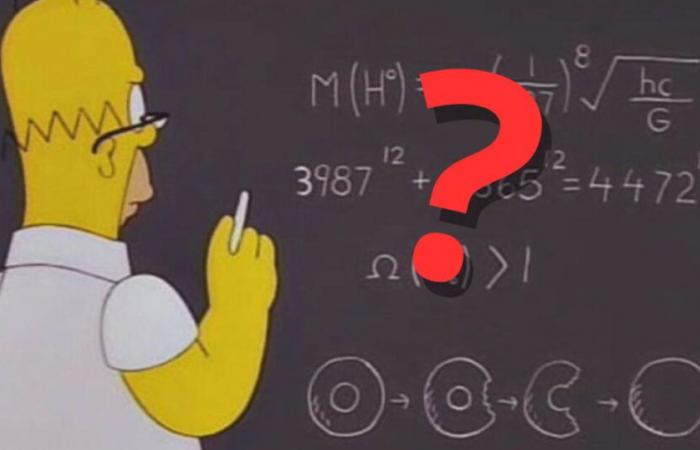Known for his clumsiness and his insatiable appetite for donuts, Homer Simpson surprised the world by scribbling an equation that touches on a major scientific discovery. In a cult episode, the hero of The Simpsons ventures onto a blackboard and disturbingly anticipates scientific concepts that researchers will take years to verify.
The stupidest, stupidest, most idiotic of men – and there are many of them in the race – is also one of the most intelligent. Weird ? Actually, not so much. Over the years, as his stunningly accurate predictions – like the presidency of Donald Trump or, in another register, the arrival of automatic correction, the series The Simpsons never ceased to surprise. Time and time again, Matt Groening's delirious fiction has transcended the small screen to resonate in our reality. And this since the broadcast of its first episode in 1989. Nine years later, the episode entitled Homer's Latest Inventionor The Wizard of Evergreen Terraceis broadcast. In it, Homer Simpson goes through an existential crisis which leads him to dream of being an inventor like Thomas Edison. At the turn of a scene, he stands in front of a blackboard covered with seemingly absurd equations. But, one of these formulas approximately predicts the mass of the Higgs bosona fundamental particle that explains why objects have mass. But how to explain it?
Simon Singhphysicist and author of the book The Simpsons and Their Mathematical Secretsanalyzed this scene. “If you calculate this equation, it gives a mass for the Higgs boson slightly higher than its true value. It's incredible that Homer came up with this estimate 14 years before CERN confirmed his discovery.”he declared to The Independent in 2015, the first media to reveal the discovery of Homer. The true mass of the bosonmeasured in 2012, is approximately 125 gigaelectron volts (GeV). Homer's equation leads to a value of 775 GeVa distant approximation but plausible for the knowledge of the time. David Kaplan, a physicist at Johns Hopkins University, said in the Los Angeles Times that this calculation, although slightly erroneous, remained “within the realm of possibility” at the end of the 1990s. Could do better… But not bad Homer, not bad!
When mathematicians dare to use humor…
So no, Homer Simpson did not discover the Higgs boson. As its name suggests, the latter was theorized as early as 1964 par Peter Higgs and other physicists. No, he didn't solve the equation in question: he was somehow “very wrong”. Good enough to attract the attention of scientific luminaries. Obviously, behind this “quasi-prowess” lie the mathematical talents, not of Homer, but of writers of the series. David X. Cohen, a computer science graduate, collaborated with astronomer David Schiminovich to develop a credible equation. They combined fundamental constants like the speed of light and the gravitational constant to achieve a consistent result. This table not limited to the Higgs boson. Another line offers a humorous counter-example to Fermat's theorem. The latter states that it is impossible to find numbers x, y, and z such that xn+yn=znx^n + y^n = z^n, if n is greater than 2. Don't panic, it was the only technical part of this article. Of the private jokes of mathematicians, in short.
“The most mathematical series in history”
The Simpsons is much more than just an animated series. Since its launch, like the Higgs boson, it full of mathematical references subtle and complex. According to Singh, interviewed by The Independent, “The Simpsons is the most mathematical prime-time television series in history. Many of the writers have degrees in mathematics or physics”. Among them, Al Jean, executive producer, is graduate in mathematics from Harvardwhere he entered at just 16 years old. THE Guardian reports that the writing team also includes doctoral students and researchers having swapped their laboratories for animation studios. These brilliant minds inserted into the series concepts like Mersenne prime numbers, Gödel's theorem and jokes about p. Twisting, isn't it? At any rate, Homer's Latest Invention reflects the perfect balance between humor and science. On his blackboard, Homer also scribbles references to the topologysuggesting that the universe could look like a torus (half-cylinder molding that strangely resembles a donut). A bold metaphor that doubles as an obvious nod to his love of donuts. These clever touches aren't just a fun detail. “If a teenager spots these math jokes, it may push them to see math as something cool”he confided to Guardian. And there is work. Anyway, if you thought only pimply pre-teens watched The Simpsonsthink again!
Sources :
You may also be interested in:
Queen: legendary rock quartet yes, but also a talented scientific trio!
South Park: how is the animated series a sharp critique of American society?
“Wednesday”: Why is the Addams Family the perfect critique of the traditional family model?
Ancient Egypt: Drawing resembling Marge Simpson discovered in mummy's sarcophagus
These 5 Pokémon exist in real life!






